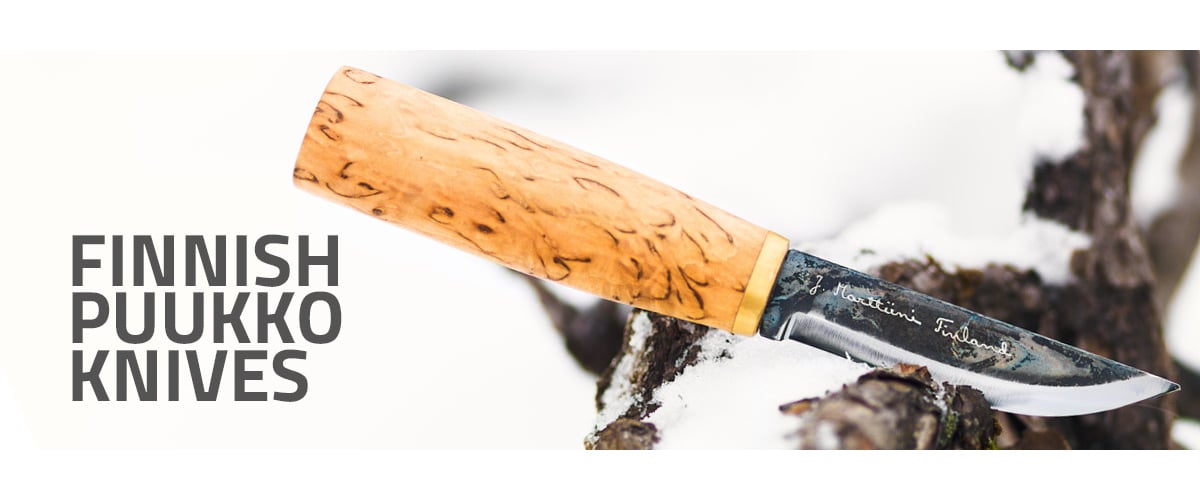The story of the finnish puukko
The Finnish puukko is a living legend. It has enjoyed popularity across national borders for centuries and even today it’s valued all over the world. Its history goes far back into the end of the Vendel Period and the beginning of the Viking Age (790-793 AD) way before the strong advent of Christianity in the Fennoscandic peninsula around 1100.
At first the puukko was simply a utility tool for human support and security, but over time Finns, especially wealthy ones, began to pay attention to its aesthetics as well.
Around 1000 AD, came bronze plated sheaths, carved and engraved handles, metal rings and decorations, gifting us with spectacular objects such as the Inari Puukko, but still retaining every bit of performance.
The reputation of the Finnish puukko suffered in the 19th century, when a group of men we call häjyt did bad deeds in the Pohjanmaa province. They were groups of outlaws who used the puukko for robbery and murder.
Even today almost every Finn still associates the puukko with locations such as Kauhava, Ylihärmä, Alahärmä and Lapua. As well as to people like Antti Isotalo and Antti Rannanjärvi, the two most legendary outlaws of that period. Nonetheless, despite the violence, this period has brought a unique mystique to the history of the puukko.
Finnish knives today
Nowadays we have factory-made puukkos alongside handcrafted ones, but the original idea has not faded: the support and security of its owner. It’s a versatile tool in the home workshop and in the wilderness, in everyday life and in celebrations. With a puukko a hiker tackles fire making and may build a lean-to shelter, a hunter skins and butchers the game, a fisherman guts and handles the fish, an artist carves and engraves woodenware.
Most typically a modern puukko has a simple wooden handle and a straight spined flat section blade. Bevels are usually flat or very mildly hollow, running about half the height of the blade, with a sharpening angle usually spanning from 18° to 22° inclusive. The very edge could be either ground to zero or have a very small secondary bevel for added strength. The biggest advantages of this grind are:
- Its capacity to take a way keener bite than a wider edge angle.
- The great ability to glide into the fibers while carving wood.
- And, especially when hollow or with a tiny micro bevel, its ease of sharpening.
The most traditional material combination for a puukko is a birch handle and a carbon steel blade. However, stainless and powder steels are now also relatively common, while, depending on region of provenance or wanted style, deer and reindeer antlers, leather, rubber, micarta and G-10 can also be found as handle materials.
The Finnish puukko types and their names
As the pike-gutting Son of the Sun could testify, the puukko is quite a universal knife, in his case not even knowing heavenly boundaries.
On a serious note, the most common use for a puukko is still cutting and carving wood: such a puukko being called nikkarinpuukko, with its oldest incarnation in the humble maasepän puukko, literally “village smith knife”.
A good number of regional models still exist as well.
There are the horsehead festive models from Kauhava, perfected by cousins Iisakki Järvenpää and Juho Lammi, who even crafted puukkos for none other than tsar Nikolai II Romanov, when Finland was a grand duchy for the Russian empire.
Then the Härmä puukko, indissolubly connected to the aforementioned Antti Rannanjärvi, as his grandnephew, also called Antti Rannanjärvi, still crafts them.
Then the birch bark-handled Pekanpää puukko, named after a village in the Tornio region.
Or take the extra elegant Rautalampi puukko, created by Emil Hänninen, which received the bronze medal at the Exposition Universelle of Paris in 1900. Started as a personal variation on the Kauhava models, Hänninen was able to develop a completely new series of decorations and aesthetic features, strongly separating the Kauhava and the Rautalampi models. An almost extinct puukko at some point, it’s now still crafted thanks to the passion and research of master bladesmith Arto Liukko.
The Toijala puukko, named after a small village south of Tampere, often called the most elegant and most difficult to craft of all the festive puukkos, with its metal plated sheath, requiring the foils to not be thicker than 0,6 mm when the job is done. There is a possibility that the Toijala puukko was influenced by regional models from central Norway. They also have metal plated sheaths, though not so extensively. Similarly to the Rautalampi, the Toijala as well was saved from disappearance by another master bladesmith: Jukka Hankala.
But the most famous of all, even outside of Finland’s borders is the Tommi puukko, created by Kalle Keränen around 1873. Keränen was also the first known Finnish smith to use oil quenching, following his apprenticeship in Fiskars under English metallurgist Thomas Woodward. Truth be told, part of the Tommi’s fame also comes from its not-so peaceful use during the Winter War against Stalin’s Red Army.
Summary: The Finnish puukko is alive and well
The name of the Finnish puukko is going strong and as more puukkos are exported to the world, the greater its reputation grows.
In addition to Marttiini, now part of the Rapala VMC Corporation, our country is still full of workshops, individual blacksmiths and visionary craftsmen who swear by the name of Ilmarinen and produce completely unique works of art.
The Kamppila family from Kauhava is known for their Ahti puukkos and J-P Peltonen’s Ranger Knife (Sissipuukko), especially popular in the Finnish army. A former master engraver for Iisakki Järvenpää Oy, Simo Passi combines old and modern methods.
The legendary Heimo Roselli is known as the man who developed the UHC steel, a modern rendition of the ancient Wootz indian steel.
Old master bladesmiths Iisakki Järvenpää, Kustaa Lammi, Altti Kankaanpää and Yrjö Puronvarsi, have since passed down the torch to the future generations. The innovative Pasi Jaakonaho is known for his ecological thinking and the use of recycled materials. Puronvarsi’s nephew Antti Mäkinen has inherited the family business and keeps the name honoured.
Otto Kemppainen, who manufactures custom knives under the name of Kemp Knives, brings along the enthusiasm of youth and a new kind of skill. Jukka Hankala and Pekka Tuominen are the most famous bladesmiths outside of Finland’s borders, Arto and Jari Liukko are the unquestioned masters of the Rautalampi and Kauhava festive models...
After reading all of this, surely you’re interested in finding a puukko for yourself. At Lamnia, you will find a huge selection of different Finnish puukkos and our friendly staff will be happy to help you make your choice.

